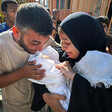Rights and Accountability 10 June 2019

Israeli police raid Umm al-Hiran, a village slated for demolition, 18 January 2017. A resident of the village and police officer were killed during the raid.
ActiveStillsThe killing of math teacher Yaqoub Abu al-Qiyan during an early 2017 raid on a Palestinian village was in many respects a typical act of violence by Israel’s colonization project. A Palestinian was left dead, others injured and homes were destroyed – starting with those belonging to Abu al-Qiyan’s family – to make way for a Jewish settlement.
There are unique aspects to his case – he was killed in Israel, not in the occupied West Bank, for one. And thanks to the UK-based research group Forensic Architecture, a moment-by-moment breakdown of the events leading up to Abu al-Qiyan’s death and the state cover-up that followed has been made publicly available.
When Yaqoub Abu al-Qiyan was killed in a Bedouin village slated for demolition on 18 January 2017, Benjamin Netanyahu immediately alleged he had carried out a “terror attack.”
The narrative pushed by Israel’s prime minister, as well as interior minister Gilad Erdan and police spokesperson Micky Rosenfeld, was that Abu al-Qiyan was attempting to attack officers with his car, killing officer Erez Levi. Rosenfeld and police chief Roni Alsheikh even claimed that Abu al-Qiyan had links to the Islamic State group.
But residents of Umm al-Hiran, the Naqab desert village in southern Israel stormed by hundreds of officers that day, as well as activists present, swiftly challenged the government’s narrative of events. They said that Abu al-Qiyan was killed without provocation.
Video recorded by Keren Manor, a member of the Activestills collective whose work has previously appeared on The Electronic Intifada, proved critical to unraveling Israel’s narrative.
Analysis from Forensic Architecture indicated that Abu al-Qiyan, a Palestinian citizen of Israel, was driving slowly and his vehicle only accelerated after he was shot at by police, suggesting he had lost control of his car.
Leaked details from Abu al-Qiyan’s autopsy report “suggested that the bullet had crushed al-Qiyan’s right leg, which controlled the accelerator and brake pedals, suggesting our theory that the acceleration of his vehicle was the result of gunfire,” according to Forensic Architecture. A second bullet hit Abu al-Qiyan in the chest, and “led to his death from loss of blood.”
Israel’s official narrative soon fell apart, but Forensic Architecture “wanted to understand better what had happened in the moments leading to Abu al-Qiyan’s death.”
Mishandling of evidence
The research group has published a new video report that includes more documentation contradicting Israel’s claims. That documentation includes newly available footage from body and handheld cameras operated by police officers at the scene, a “partial and incomplete” police evidence file, the full recording of the thermal aerial video, and recordings of police radio channels.
The body cam footage recorded by one of the officers indicated that Forensic Architecture’s earlier suspicion that Abu al-Qiyan was killed by a single bullet fired at close range while his car had come to a stop – to “confirm the kill” – was unlikely.
The research group also used reenactment at the scene of Abu al-Qiyan’s killing, as well as synchronization of audio and video documentation, 3D modeling and other methodologies, to reach its conclusions.
A reenactment using the same model of vehicle as the one driven by Abu al-Qiyan indicated that the slope of the terrain on which he was driving, rather than the gas pedal, caused the acceleration of his car.

Ruins of demolished homes in Umm al-Hiran on 18 January 2017. Israel plans to completely demolish the village in order to build a Jewish-only town on that land.
ActiveStillsIt also studied the injury of Ayman Odeh, then the senior Palestinian lawmaker in Israel’s parliament, during the same incident. The group’s conclusions support Odeh’s claim that he was hit in the head by a sponge bullet fired by Israeli police.
The research group notes that police prevented medics from accessing Abu al-Qiyan while he bled to death in his vehicle. “Abu al-Qiyan’s life could have been saved,” the report states.
Regarding the cover-up of the truth about the killing of Abu al-Qiyan and Levi, as well as the wounding of Odeh, Forensic Architecture states: “Our work pitted us directly against Israeli politicians and police chiefs, and exposed inconsistencies in the official account of the event, as well as mishandling of evidence after the fact.”
As the video report shows, Israeli police accused Forensic Architecture of using a “manipulative edit” of leaked thermal footage recorded from a police helicopter “that distorts evidence.”
Yet it was the Israeli police that manipulated evidence and doctored video to support its narrative.
Redactions in the police report in the evidence file given to lawyers suggested that additional footage was recorded but missing from the evidence file.
Gaps at critical moments
A year and a half after the incident, footage was leaked by a police officer to an Israeli TV channel and sent to a prosecutor “who was considering whether to press charges against the policeman involved,” Forensic Architecture states.
The edited video broadcast by Israel’s Channel 10 purports to show that Odeh was injured by a fragment of a stun grenade. Police accused Odeh of giving false testimony by saying he was hit with a sponge bullet.
Forensic Architecture analyzed the video and found that it was “made up of multiple clips and that gaps in the footage occurred at critical moments.”
A whole page is missing from the transcript in the evidence file of the interrogation of the police cameraman. The missing page contains the conversation between the cameraman and interrogator as they watch the original, uncut footage that was leaked to Channel 10.
“The incident that began with a dead-of-night raid on the village of Umm al-Hiran became host to many more violations. It led to the killing of Abu al-Qiyan, to assaults against residents, activists and politicians, and the subsequent manipulation of evidence,” Forensic Architecture states.
“To date, no policeman has been charged for the violence in Umm al-Hiran. The shooting of Abu al-Qiyan was justified as a split-second decision taken legitimately by the policeman involved,” the group concludes.
“But instinct is culturally and politically produced and the victims of police violence in Israel are disproportionately Palestinian. In this way, a long history of separation and marginalization is condensed in a split-second.”





